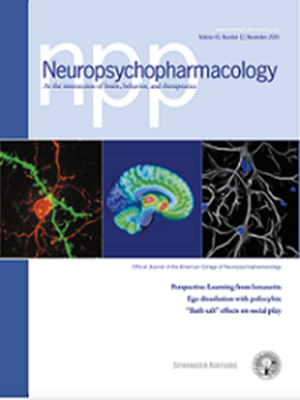Neighborhood social fragmentation in relation to impaired mismatch negativity among youth at clinical high risk for psychosis and healthy comparisons
IF 6.6
1区 医学
Q1 NEUROSCIENCES
引用次数: 0
Abstract
Impairments in mismatch negativity (MMN) are well-established in schizophrenia and have been observed in youth at clinical high-risk for psychosis (CHR-P). Prior animal studies have shown that social isolation may be related to neurobiological changes, including reduced MMN-like responses and schizophrenia-like behaviors. In parallel, neighborhood social fragmentation has been shown to be associated with the onset of psychosis. This study investigates the association between neighborhood social fragmentation and MMN impairment among CHR-P youth and healthy comparisons (HC). Data were collected from the North American Prodrome Longitudinal Study Phase 2. Electroencephalography was recorded during an unattended auditory oddball paradigm with duration-, pitch-, and double-deviant tones. Generalized linear mixed models tested the association between neighborhood social fragmentation and the frontal-central averaged MMN for three deviant types for youth at CHR-P and HC separately. The models adjusted for age, sex, race/ethnicity, parental education, parental history of psychosis, and neighborhood poverty. Participants (mean [SD] age: 18.69 [4.59], 41.9% females, 51.3% White non-Hispanic) included 304 CHR-P and 92 HC. In the CHR-P group, greater neighborhood social fragmentation was associated with impaired duration-deviant MMN (bootstrapped β = 0.18, 95% CI: 0.04 to 0.33, p = .022) but not for pitch-deviant (bootstrapped β = 0.09, 95% CI: −0.05 to 0.22, p = .199) or double-deviant MMN (bootstrapped β = 0.10, 95% CI: −0.09 to 0.17, p = .559). Greater neighborhood social fragmentation was associated with impaired duration-deviant MMN amplitude among high-risk individuals. Further research is needed to explore underlying mechanisms.

社区社会分裂与临床精神病高危青少年失配负性受损的关系及健康比较
失配负性(MMN)的损伤在精神分裂症中是公认的,并且在精神病临床高危青年(chrp)中观察到。先前的动物研究表明,社会隔离可能与神经生物学变化有关,包括mmn样反应和精神分裂症样行为的减少。与此同时,社区社会分裂已被证明与精神病的发病有关。本研究探讨了社区社会分裂与chrp青年和健康比较者(HC) MMN损伤的关系。数据收集自北美前驱期纵向研究第二阶段。脑电图记录在一个无人看管的听觉怪异的范式与持续时间,音高,和双偏差的音调。广义线性混合模型分别检验了社区社会碎片化与三种越轨类型青年的额-中央平均MMN之间的关系。这些模型根据年龄、性别、种族/民族、父母受教育程度、父母精神病史和社区贫困状况进行了调整。参与者(平均[SD]年龄:18.69[4.59],41.9%为女性,51.3%为非西班牙裔白人)包括304名chrp和92名HC。在chrp组中,更大的社区社会分裂与持续偏差MMN受损相关(bootstrap β = 0.18, 95% CI: 0.04至0.33,p = 0.022),但与音调偏差(bootstrap β = 0.09, 95% CI: -0.05至0.22,p = 0.199)或双偏差MMN (bootstrap β = 0.10, 95% CI: -0.09至0.17,p = 0.559)无关。在高危人群中,更大的社区社会分裂与持续偏差MMN振幅受损有关。需要进一步的研究来探索潜在的机制。
本文章由计算机程序翻译,如有差异,请以英文原文为准。
求助全文
约1分钟内获得全文
求助全文
来源期刊

Neuropsychopharmacology
医学-精神病学
CiteScore
15.00
自引率
2.60%
发文量
240
审稿时长
2 months
期刊介绍:
Neuropsychopharmacology is a reputable international scientific journal that serves as the official publication of the American College of Neuropsychopharmacology (ACNP). The journal's primary focus is on research that enhances our knowledge of the brain and behavior, with a particular emphasis on the molecular, cellular, physiological, and psychological aspects of substances that affect the central nervous system (CNS). It also aims to identify new molecular targets for the development of future drugs.
The journal prioritizes original research reports, but it also welcomes mini-reviews and perspectives, which are often solicited by the editorial office. These types of articles provide valuable insights and syntheses of current research trends and future directions in the field of neuroscience and pharmacology.
 求助内容:
求助内容: 应助结果提醒方式:
应助结果提醒方式:


